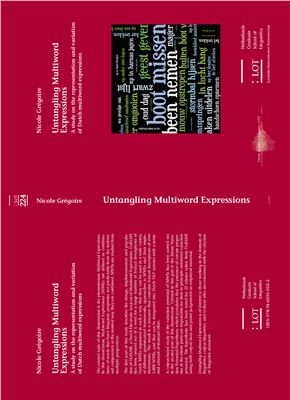Год издания: 2009
Количество страниц: 206
ISBN 978-94-6093-010-2
Язык: English
It is the regularity of natural language that makes a language understandable and leaable. It is its (apparent) irregularity and unpredictability that keeps many linguists (and language leaers) busy. Regularities in language can be expressed by grammatical rules, e.g. the past tense of the majority of English verbs can be formed by a rule that suffixes -ed to the stem. There are, however, a number of English verbs that do not obey this rule, e.g. the past tense of eat is ate and not eated, and are therefore called irregular. Regularity and irregularity can be found at both the word and the phrase level. There are rules that alter word forms to create new ones and, as shown in the past tense example, there are exceptions to these rules. There are syntactic rules that combine words into grammatically correct phrases and sentences, and although there are no rules that assign meaning to words, there is a rule (or principle) that says that the meaning of a phrase or sentence can be derived from the meaning of its parts and the way they are combined. But also at the phrase level there are exceptions to these rules, yielding linguistically idiosyncratic
combinations. It is this type of irregularity, i.e. combinations of words with idiosyncratic and unpredictable properties, that I am interested in and that is the subject of this study.
Количество страниц: 206
ISBN 978-94-6093-010-2
Язык: English
It is the regularity of natural language that makes a language understandable and leaable. It is its (apparent) irregularity and unpredictability that keeps many linguists (and language leaers) busy. Regularities in language can be expressed by grammatical rules, e.g. the past tense of the majority of English verbs can be formed by a rule that suffixes -ed to the stem. There are, however, a number of English verbs that do not obey this rule, e.g. the past tense of eat is ate and not eated, and are therefore called irregular. Regularity and irregularity can be found at both the word and the phrase level. There are rules that alter word forms to create new ones and, as shown in the past tense example, there are exceptions to these rules. There are syntactic rules that combine words into grammatically correct phrases and sentences, and although there are no rules that assign meaning to words, there is a rule (or principle) that says that the meaning of a phrase or sentence can be derived from the meaning of its parts and the way they are combined. But also at the phrase level there are exceptions to these rules, yielding linguistically idiosyncratic
combinations. It is this type of irregularity, i.e. combinations of words with idiosyncratic and unpredictable properties, that I am interested in and that is the subject of this study.

